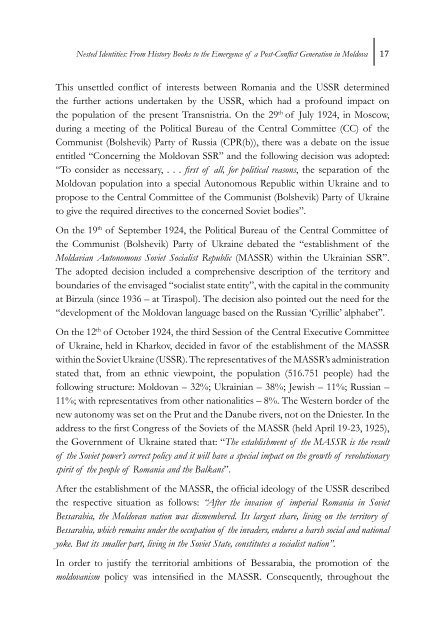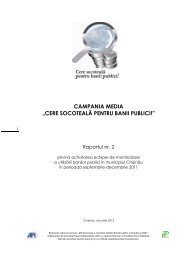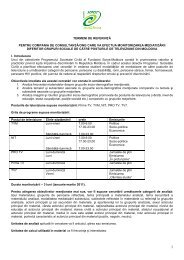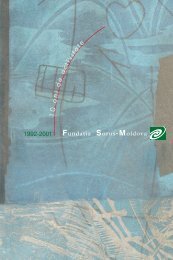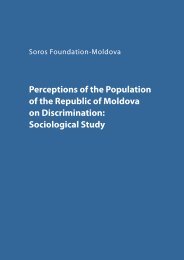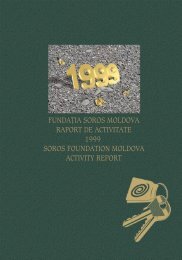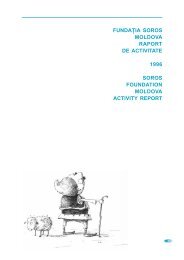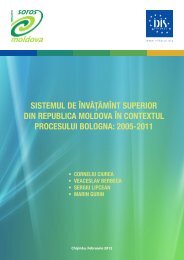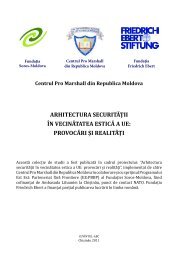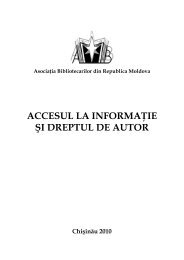Managing Intractable Conflicts: Lessons from Moldova and Cyprus
Managing Intractable Conflicts: Lessons from Moldova and Cyprus
Managing Intractable Conflicts: Lessons from Moldova and Cyprus
Create successful ePaper yourself
Turn your PDF publications into a flip-book with our unique Google optimized e-Paper software.
Nested Identities: From History Books to the Emergence of a Post-Conflict Generation in <strong>Moldova</strong><br />
17<br />
This unsettled conflict of interests between Romania <strong>and</strong> the USSR determined<br />
the further actions undertaken by the USSR, which had a profound impact on<br />
the population of the present Transnistria. On the 29 th of July 1924, in Moscow,<br />
during a meeting of the Political Bureau of the Central Committee (CC) of the<br />
Communist (Bolshevik) Party of Russia (CPR(b)), there was a debate on the issue<br />
entitled “Concerning the <strong>Moldova</strong>n SSR” <strong>and</strong> the following decision was adopted:<br />
“To consider as necessary, . . . first of all, for political reasons, the separation of the<br />
<strong>Moldova</strong>n population into a special Autonomous Republic within Ukraine <strong>and</strong> to<br />
propose to the Central Committee of the Communist (Bolshevik) Party of Ukraine<br />
to give the required directives to the concerned Soviet bodies”.<br />
On the 19 th of September 1924, the Political Bureau of the Central Committee of<br />
the Communist (Bolshevik) Party of Ukraine debated the “establishment of the<br />
Moldavian Autonomous Soviet Socialist Republic (MASSR) within the Ukrainian SSR”.<br />
The adopted decision included a comprehensive description of the territory <strong>and</strong><br />
boundaries of the envisaged “socialist state entity”, with the capital in the community<br />
at Birzula (since 1936 – at Tiraspol). The decision also pointed out the need for the<br />
“development of the <strong>Moldova</strong>n language based on the Russian ‘Cyrillic’ alphabet”.<br />
On the 12 th of October 1924, the third Session of the Central Executive Committee<br />
of Ukraine, held in Kharkov, decided in favor of the establishment of the MASSR<br />
within the Soviet Ukraine (USSR). The representatives of the MASSR’s administration<br />
stated that, <strong>from</strong> an ethnic viewpoint, the population (516.751 people) had the<br />
following structure: <strong>Moldova</strong>n – 32%; Ukrainian – 38%; Jewish – 11%; Russian –<br />
11%; with representatives <strong>from</strong> other nationalities – 8%. The Western border of the<br />
new autonomy was set on the Prut <strong>and</strong> the Danube rivers, not on the Dniester. In the<br />
address to the first Congress of the Soviets of the MASSR (held April 19-23, 1925),<br />
the Government of Ukraine stated that: “The establishment of the MASSR is the result<br />
of the Soviet power’s correct policy <strong>and</strong> it will have a special impact on the growth of revolutionary<br />
spirit of the people of Romania <strong>and</strong> the Balkans”.<br />
After the establishment of the MASSR, the official ideology of the USSR described<br />
the respective situation as follows: “After the invasion of imperial Romania in Soviet<br />
Bessarabia, the <strong>Moldova</strong>n nation was dismembered. Its largest share, living on the territory of<br />
Bessarabia, which remains under the occupation of the invaders, endures a harsh social <strong>and</strong> national<br />
yoke. But its smaller part, living in the Soviet State, constitutes a socialist nation”.<br />
In order to justify the territorial ambitions of Bessarabia, the promotion of the<br />
moldovanism policy was intensified in the MASSR. Consequently, throughout the


